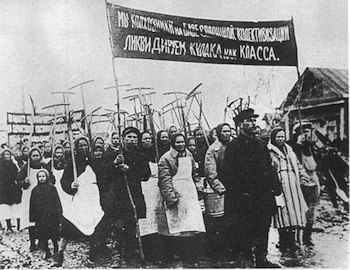

|
The War against the 'Kulaks'  'We kolkhoz workers call for the liquidation of the kulaks as a class' Peasants who spoke out against collectivization were threatened and harassed; many were expelled as 'kulaks' from their homes and driven out of the village. There were attacks on the church, which was regarded by the Bolsheviks as a source of potential opposition to collectivization. Thousands of priests were arrested and exiled, churches looted and destroyed. The war against the 'kulaks' was not a side-effect but the main driving force of the collectivization campaign. It had two main aims: to remove potential opposition to collectivization; and to serve as an example to the other villagers, encouraging them to join the collective farms in order not to suffer the same fate. As Stalin saw it, there was nothing to be gained from trying to neutralize the 'kulaks', nor from attempting to involve them as farm labourers in the kolkhoz, as some Bolsheviks proposed. 'When the head is cut off,' Stalin argued, 'you do not weep about the hair.' In January 1930, a Politburo commission drew up a target of 60,000 'malicious kulaks' to be sent to labour camps and 150,000 other 'kulak' households to be exiled to the North, Siberia, the Urals and Kazakhstan. The figures were part of an overall plan for 1 million 'kulak' households (about 6 million people) to be dispossessed and sent to labour camps or 'special settlements.' The rural Soviet, Komsomol and Party activists drew up lists of 'kulaks' for arrest in each village. In some places the peasants chose the 'kulaks' from their own number (isolated farmers, widows and old people were particularly vulnerable) or drew lots to decide. |
© 2014 Orlando Figes | All Rights Reserved